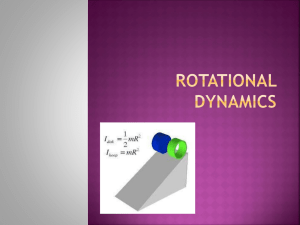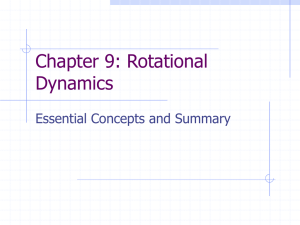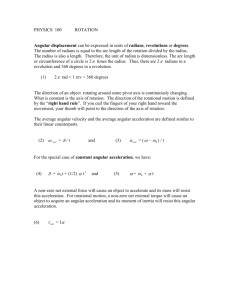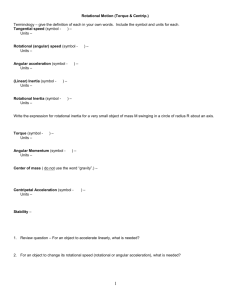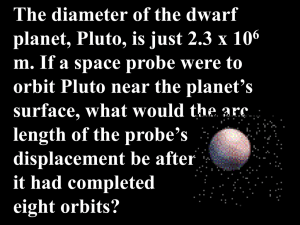CH10&11 - Bama.ua.edu
advertisement
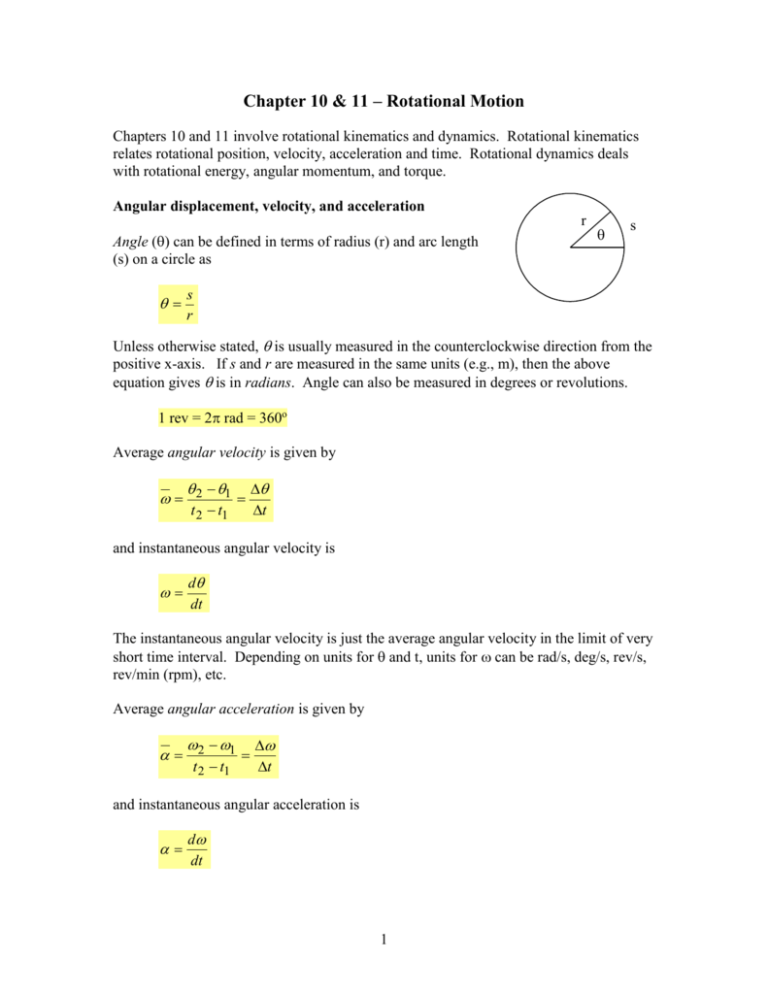
Chapter 10 & 11 – Rotational Motion Chapters 10 and 11 involve rotational kinematics and dynamics. Rotational kinematics relates rotational position, velocity, acceleration and time. Rotational dynamics deals with rotational energy, angular momentum, and torque. Angular displacement, velocity, and acceleration r Angle () can be defined in terms of radius (r) and arc length (s) on a circle as s s r Unless otherwise stated, is usually measured in the counterclockwise direction from the positive x-axis. If s and r are measured in the same units (e.g., m), then the above equation gives is in radians. Angle can also be measured in degrees or revolutions. 1 rev = 2 rad = 360o Average angular velocity is given by 2 1 t 2 t1 t and instantaneous angular velocity is d dt The instantaneous angular velocity is just the average angular velocity in the limit of very short time interval. Depending on units for and t, units for can be rad/s, deg/s, rev/s, rev/min (rpm), etc. Average angular acceleration is given by 2 1 t 2 t1 t and instantaneous angular acceleration is d dt 1 Units for angular acceleration can be rad/s2, deg/s2, rev/s2, rev/min2, etc. The relationships above are mathematically similar to those for motion in 1-D. Thus, we can get the equations for constant angular acceleration from those for constant linear acceleration by appropriately changing the variables. Rot. motion with constant 1-D motion with constant a x v0 t 1 a t 2 x 0 t 1 t 2 2 v v0 a t v a 0 t 2 v 2 v0 2 2 a x 2 0 2 2 It is important that the units in the above equations be compatible. For example, if is in rad/s2, then should be in rad/s, t in s, and you will get in rad. Also, don’t mix the left and right equations above. For example, the equation v0 t 1 t 2 would not make 2 sense. Also, don’t confuse and a, although they look similar. Example: A wheel increases its rotational velocity from 200 rpm to 300 rpm in 10 sec. What is its angular acceleration in rad/s2? 0 (200 rev / min)( 1 min/ 60s)( 2 rad / rev ) 20.9 rad / s (300 rev / min)( 1 min/ 60s)( 2 rad / rev ) 31.4 rad / s 0 31.4 rad / s 20.9 rad / s 1.05 rad / s 2 t t 10 s How many turns did the wheel make? 0 t 1 t 2 (20.9 rad / s)(10 s) 1 (1.05 rad / s 2 )(10 s) 2 261.5 rad 2 2 41.6 2 ( ) ( Or , use t 0 t) no. turns 2 2 Relationships between angular and linear motion Since s = r, then it follows that ds d r , dt dt or vt r dvt d , or at r r dt dt In the above, vt is the tangential speed of a point going around a circle and at is the component of acceleration tangent to the circle. Example: A merry-go-round rotates at a constant angular speed. It takes 20 sec to make a complete revolution. What is the speed of a rider who is 4 m from the center? 2 rad 0.314 rad / s t 20 s vt r (4 m)(0.314 rad / s) 1.26 m / s The speed of a rider increases as he moves further from the center. Combined tangential and centripetal acceleration We have previously shown that an object moving in a curved path can have both a tangential acceleration, as discussed above, and a radial (or centripetal) acceleration. dv at dt v2 ar r at v a The total acceleration is the vector sum: ac a ar at Since these two components of the acceleration are mutually perpendicular, then the magnitude of the total acceleration is a at 2 a r 2 r 2 2 r 2 4 r 2 4 3 Example: The merry-go-round in the above example slows uniformly and comes to rest in a time of 2 minutes. What the total acceleration of a rider when his tangential speed is 1 m/s? (0 0.314) rad 0.0523 rad / s 2 t 60 s at r (4m)( 0.0523rad / s 2 ) 0.209 m / s 2 ar v 2 (1m / s ) 2 0.25 m / s 2 r 4m a (0.209) 2 (0.25) 2 0.326 m / s 2 The angle that the acceleration makes with the radial direction is at ar tan 1 0.209 o tan 1 40 0 . 25 The angle is in the ‘backward’ direction. Rotational Kinetic Energy For a rigid object rotating about an axis, all the pieces that make up the object rotate in a circle with the same angular velocity . Thus, the kinetic energy is K rot 1 mv 2 1 m 2 r 2 1 mr 2 2 1 I 2 2 2 2 2 where, I mr 2 , is defined as the rotational inertia of the object. y (m) m1 (0, 3m) Example: Three masses, each 2 kg, are located at the corners of a triangle consisting of light rigid rods, as shown to the right. The location (x, y) of each mass is shown. What is the rotational inertia about the x-axis? 4 x (m) m2 (-3m, -2m) m3 (3m, -2m) What matters here is the nearest distance of each mass from the axis of rotation. So, I x mr 2 m1 y12 m2 y 2 2 m3 y3 2 (2)(3) 2 (2)( 2) 2 (2)( 2) 2 34 kg m 2 If the triangle of masses rotates about the x-axis at 60 rpm, what is the rotational kinetic energy? The angular velocity must be in rad/s, so (60rpm)(1min/ 60s)( 2 rad / rev) 6.28 rad / s K rot 12 I 2 12 (34kg m2 )(6.28 rad / s)2 670 J Suggested exercise: Find the rotational inertia and rotational kinetic energy about the yaxis and about the z-axis (which is perpendicular to the page) for the same rotational velocity Rotational Inertia of a Continuous Mass Distribution For a continuous distribution of mass, I mr 2 r 2dm r 2dV where is the mass density. Example: dx What is the rotational inertia of a uniform rod about an axis passing through the end and perpendicular to the rod? dm M dx L L M M I x dm x dx L L 0 2 2 L x3 2 13 ML 3 0 For a perpendicular axis passing through the center of the rod, I L/2 2 x L / 2 M 1 ML2 dx 12 L 5 x As the above example shows, the rotational inertia of an object depends about the axis of rotation. For a given orientation, the rotational inertia is smallest if the axis is through the center of mass. For any other axis that is parallel with this axis through the center of mass, the rotational inertia is given by the parallel axis theorem, I I cm MD 2 where D is the distance between the two axes. (You can check to see that this is true for the rod example.) Rotational Intertia of Various Rolling Objects A round object that rolls also rotates about an axis through it center of mass. Below are expressions for some such rotational inertias that have been determined by integrating over the volume of the object. Object cylindrical shell Rotational Inertia solid cylinder I 1 M R2 I M R2 2 I 2 M R2 3 I 2 M R2 5 spherical shell solid sphere Torque Torque can cause an object to rotate. The torque depends on the force and on the point at which the force is applied relative to the axis of rotation. Specifically, torque is the product of the force and the nearest distance between the line of action of the force and the axis or rotation, Fd (units are N-m) F F = F sin If r is the distance from the point of application of the force to the pivot, then d = r sin (called the ‘lever arm’). We can also write pivot r Fr F sin r where F = F sin is the component of F that is perpendicular to r. 6 F = F cos In vector notation, the torque if the cross product (vector product) of r and F: rF The direction of is perpendicular to the plane formed by r and F. It would be along the axis of rotation due to the torque. The torque due to the force shown in the diagram would produce a counter-clockwise rotation about the pivot and is assumed to be positive. The direction of the torque would be out of the plane. A torque that would produce a clockwise rotation is negative and would be directed into the plane in the diagram. Example: A disk pivoted about an axis through its center is subjected to two forces, as shown to the right. Given: F1 = 10 N, F2 = 5 N, d1 = 8 cm, d2 = 5 cm. What is the net torque? d1 d2 F1 F2 = F1d1 – F2d2 = (10 N)(0.08 m) – (5 N)(0.05 m) = 0.8 N-m – 0.25 N-m = 0.55 Nm Torque and Angular Acceleration For a single point mass going in a circle subject to a tangential force, Ft mat mr (it also has a centripetal component of force and acceleration) The torque is then Ft r mr 2 , or mr 2 For a rigid body consisting of many masses, each mass goes in a circle and has the same angular acceleration . Thus, the net torque is mr 2 I 7 Example: For the disk in the example above that is subjected to two forces, assume that the radius is R = 15 cm and the mass is 5 kg. What is the angular acceleration of the disk? I 12 MR 2 12 (5kg)(0.15m) 2 0.0563 kg m 2 0.55 N m 9.8 rad / s 2 I 0.0563kg m 2 Example: An Atwood machine consists of two masses hanging by a string over a pulley, as shown below. I, R T1 m1 T2 T1 a m2 T2 a 1 2 m1 g m2 g Determine an expression for the acceleration of the masses, assuming that friction can be neglected. The pulley has inertia I and radius R. We apply the 2nd law to mass 1, mass 2, and the pulley. mass 1 : m1 g T1 m1a mass 2 : T2 m2 g m2 a pulley : T1R T2 R I Ia / R, or , T1 T2 Ia / R 2 By adding the first two equations we get T1 T2 (m1 m2 ) g (m1 m2 )a Using the third equation to eliminate T1 - T2, we get Ia / R 2 (m1 m2 ) g (m1 m2 )a 8 Solving for a, a (m1 m2) g m1 m2 I / R 2 Work, Power, and Energy A torque applied to a rigid object can do work on the object if it rotates. The work done in a small angular displacement d is dW F ds F sin ds F sin rd , where is the angle between r and F. Since the = Fsinr, then dW d The power is the rate at which the work is done in rotating the object and is given by P dW d dt dt The work-energy theorem also applies to the work done by a torque. Since I I d dt W d I and d dt , then d dt I d 12 I 2 12 I02 K rot dt Rolling Objects A rolling object has both translational and rotational kinetic energy – 2 K Ktrans K rot 12 Mvcm 12 I cm 2 , where vcm is the speed of the center of mass and Icm is the rotational inertia about the rotation axis through the center of mass. Example: A ball is released from rest at the top of an inclined plane of height 2 m. What is its speed when it reaches the bottom, assuming it rolls without slipping? 9 E f Ei 1 2 Mv 2 1 I 2 Mgh 2 v/R v 2 1 Mv 2 1 I M I / R 2 v 2 Mgh 2 2 2 R 2 Mgh v M I / R2 1 2 For a solid ball of uniform density, I 52 MR 2 , so v 2Mgh 10 gh 7 M 52 M 10 (9.8)( 2) 5.29 m / s 7 Angular Momentum The angular momentum of a moving particle of mass m is defined as v L r p r mv m r The magnitude of L is axis L mvr sin mvr mvr r L depends on the distance, r, between the line of motion of the particle and the axis about which L is defined. For a rigid body rotating about a fixed axis, L is the sum of the angular momentum of all particles making up the body. L Li mi vi ri mi ( ri )ri ( mi ri 2 ) or, L I The angular momentum of an object will remain constant unless there is a torque – dL d (r p) dr dp p r dt dt dt dt 10 But dr p v mv 0 dt Thus, (For any vector, A x A = 0.) dL dp r r F , or dt dt dL dt This is analogous to Newton’s 2nd law relating the force to the time rate of change of dp linear momentum, F . dt The above equation can be extended to include the total external torque (internal torques involve action-reaction pairs and cancel) and the total angular momentum of a system of particles. This leads to the law of conservation of angular momentum, which states that the total angular momentum of a system of particles is constant if there is no net external torque. Example: A figure skater goes into a spin with her arms outstretched. She then pulls her arms in against her body. If she is initially rotating at 2 rev/s, what is her final rotational speed? Assume that by pulling in her arms she reduces her rotational inertia from 2 kg-m2 to 1.5 kg-m2. L f Li I f f I i i f I i i (2kg m 2 )( 2rev / s ) 2.67 rev / s If 1.5kg m 2 How much kinetic energy was gained or lost when she pulled in her arms? KE f 1 I f f 2 1 1.5kg m 2 (2 )( 2.67) rad / s 2 210.5 J 2 2 KEi 1 I f f 2 1 2kg m 2 (2 )( 2) rad / s 2 157.9 J 2 2 KE KE f KEi 210.5 J 157.9 J 52.6 J Thus, there was a gain in KE. Note that we had to convert angular velocity to rad/s when calculating KE. 11


